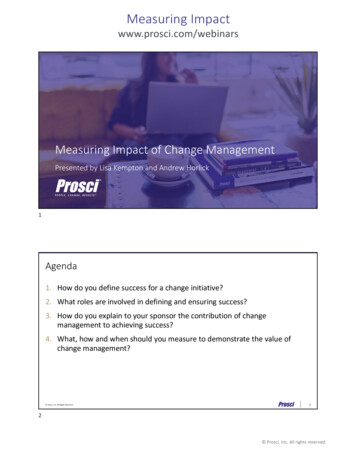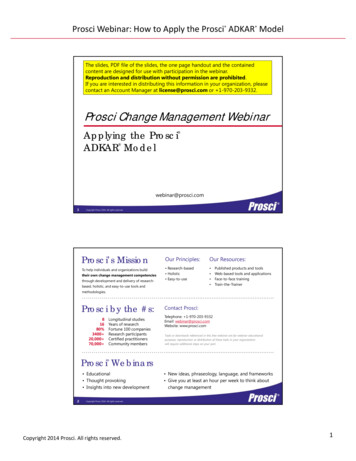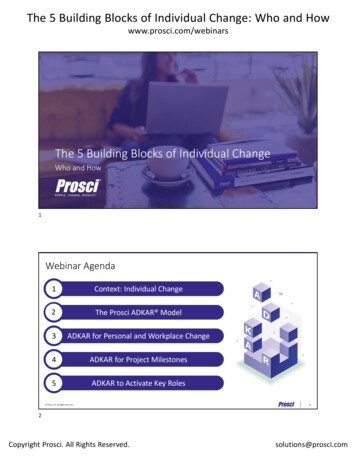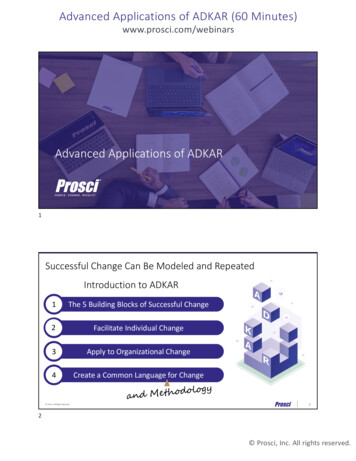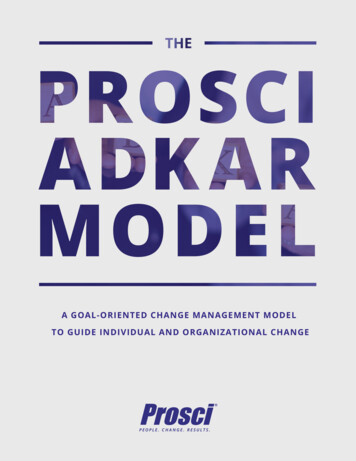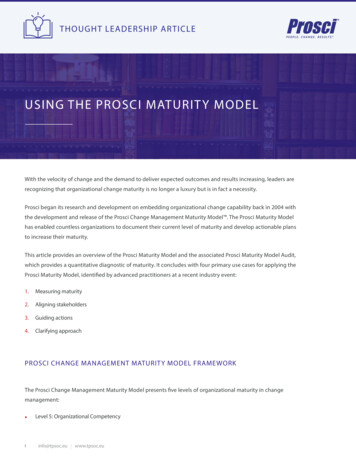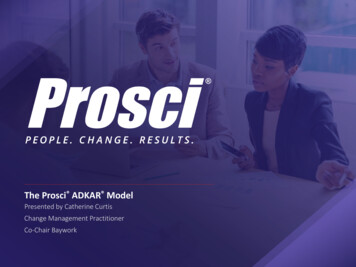
Transcription
The Prosci ADKAR ModelPresented by Catherine CurtisChange Management PractitionerCo-Chair Baywork
Agenda for presentation Defining change management Individual change management Organizational change management Who is involved in managing change Change management and project management Explanation of the ADKAR elements Application of the ADKAR Model 10 steps to manage resistance Prosci. All Rights Reserved.2
“Everyone thinks of changing theworld, but no one thinks ofchanging himself.”Leo Tolstoy Prosci. All Rights Reserved.3
Change ActivityWhat are the changes you arefacing at your organization? Prosci. All Rights Reserved.444
Change management is:The process, tools and techniques to manage thepeople side of change to achieve the requiredbusiness results. Prosci. All Rights Reserved.5
Prosci PCT Model TM Leadership / Sponsorshipprovides guidance andgovernance Project Management givesstructure to the technical sideof the change Change Management supportsthe people side of the changeProsci PCT ModelTMAll three elements must be present for project successThe Prosci Project Change Triangle (PCT) is a trademark of Prosci, Inc. All rights reserved. Prosci. All Rights Reserved.6
Leadership and sponsorshipProsci PCT ModelTM Prosci. All Rights Reserved. Leadership and sponsorship is the responsibility of executives andsenior managers in the organization who authorize, fund and charterthe top-down organizational changes that end up as projects orinitiatives. They are primarily responsible for making decisions, providingdirection, and demonstrating their own and the organization'scommitment to the particular change - whether it is a new product, anERP system, a reorganization or any number of organizational changes. The role of 'sponsor of change' is not one that can be selected orassigned; it is tied to and dictated by the actual change that is beingimplemented. From an organizational perspective, leadership is key in establishingthe strategy and direction. Effective changes are clearly aligned withthe vision and strategy of the organization. From a project perspective, leadership must support both the projectmanagement side (the technical activities to manage the developmentof a solution) and the change management side (the specific activitiesto help manage the people side of change) of a project or initiative. Leaders play key roles in supporting both the other disciplinesrepresented by the connections in the Prosci Change Triangle .7
Project management Project management is the set of processes and toolsapplied to business problems or opportunities to developand implement a solution. One of the key components is having a change defined – youmust know what is changing (processes, systems, job roles,organizational structure, etc.) in order to manage thatchange effectively. Project management involves understanding the tradeoffbetween the time, cost and scope of change that can beachieved.Prosci PCT ModelTM Prosci. All Rights Reserved. Finally, project management is the application of thediscipline called 'project management' that is a structuredapproach for managing tasks, resources, and budget in orderto achieve a defined deliverable. Successful changes applyproject management tools and processes to their initiatives.8
Change managementProsci PCT ModelTM Prosci. All Rights Reserved. Change management is the application of a set of processes, tools andpractices that are used to manage the people side of a change. Changemanagement is the bridge between “implementing a solution” and anorganization ultimately realizing the benefits associated with thechange. Change management requires two perspectives – an individualperspective (how people experience change) and an organizationalperspective (how groups can be managed through a change). Change management is the process of helping employees transitionfrom the current state to the future state (as defined by the change) ina way that minimizes productivity loss, negative customer impact andemployee turnover, while at the same time maximizes the speed ofadoption and ultimate utilization of the change throughout theorganization. Tools like communication, sponsorship and coaching are used to helpemployees make their own individual transition. Business results are only achieved when employees are involved andparticipating in the change. Change management is the final elementof realizing change effectively.9
Organizational change can be represented asthree states of changeStates of changeCurrentStateTransitionStateFutureStateHow thingsare done todayHow to movefrom currentto futureHow things willbe donetomorrow Prosci. All Rights Reserved.10
In reality, each impacted employee hashis or her own current and future state.OrganizationCurrentStateTransitionStateHow I will do my jobafter the change isimplementedHow I do myjob todayIndividual Prosci. All Rights ureState11
The organization’s future state is actually thecollection of many individual future tStateTransitionStateFutureStateFutureState Documented and Managed ProcessesCurrentStateCurrentState Prosci. All Rights FutureState New Operating Model Specialists in the Call Center Supplier Website Integrated intoSupply Chain Merged Organization12
The focus of change management is helpingindividuals make their transitionIndividualsChange management drives project successby supporting individual transitions requiredby organizational projects and initiatives Prosci. All Rights Reserved.CTFAndyCTFBeckyCTFCharlieCTFDebbie13
There are consequences of not managing thepeople side of change Lower productivity Passive resistance Active resistance Turnover of valued employees Disinterest in the current or future state Arguing about the need for change More people taking sick days or not showing up Changes not fully implemented People finding work-arounds People revert to the old way of doing things The change being totally scrapped Divides are created between ‘us’ and ‘them’ Prosci. All Rights Reserved.14
Primary Reasons for ApplyingChange Management Prosci. All Rights Reserved.Increase probability ofproject successManage employeeresistance to changeCapture peopledependent ROIBuild change competencyinto the organization15
Change management perspectives Individualperspective– Understanding how one personmakes a change successfully Prosci. All Rights Reserved. Organizational perspective– The tools that project teams andmanagers have to support the‘people side’ of change16
Managing individual change with ADKAR ADKAR describes the keybuilding blocks for successfulchange Prosci ADKAR Model – Personal or professional Success with change requiresall elements of the ADKARModel to be present Reference: Hiatt, J. ADKAR: A model for change in business, government and our community, Learning Center Publications, 2006.ADKAR is a registered trademark of Prosci. All Rights Reserved.ADKAR and “Awareness Desire Knowledge Ability Reinforcement” are a registered trademarks of Prosci, Inc. All rights reserved. Prosci. All Rights Reserved.17
The Five Building Blocks for Successful ement ADKAR and “Awareness Desire Knowledge Ability Reinforcement” are a registered trademarks of Prosci, Inc. All rights reserved. Prosci. All Rights Reserved.18
ADKAR forms the foundation of successfulorganizational change Ultimately, for a project or initiative to be successful, individualsin the organization have to do their jobs differently ADKAR provides a framework for understanding how individualschange Managers and project teams can use ADKAR to:– Guide organizational change management plans– Diagnose gaps and root causes of resistance– Develop corrective actions Prosci. All Rights Reserved.19
Prosci’s organizationalchange management processProsci 3-PhaseChange ManagementProcess A structured process for managing the‘people side’ of change on a project orinitiative– Research-based– Holistic– Easy-to-apply– Scalable Prosci. All Rights Reserved.20
Phase 1 - Preparing for ChangeMain Activities: Conduct readiness assessments Perform risk analysis Anticipate resistance areas Design special tactics Develop overall strategy Architect team structure Prepare your team Assess sponsorshipWhy? To develop a customized and scaled approachwith the necessary sponsorship and team structure. Prosci. All Rights Reserved.21
Phase 2 - Managing ChangeMain Activities: Create plans for– Communications– Sponsorship– Coaching– Training– Resistance management Integrate into project plan Execute plansWhy? To create and implement plans that willmove the organization and individuals through change. Prosci. All Rights Reserved.22
Phase 3 - Reinforcing ChangeMain Activities: Proactively collect feedback and listen to employees Audit compliance with the “new way of doing things” Identify gaps and areas of resistance Implement corrective action Celebrate successes Move to “new” business as usualWhy? To ensure that the change is adopted and sustained. Prosci. All Rights Reserved.23
Understanding the WhyChange nsAwarenessSponsor RoadmapDesireCoachingKnowledgeResistance ManagementAbilityTrainingReinforcement Prosci. All Rights Reserved.24
Who is involved in managing changeExecutives andsenior managersMiddle managersand supervisors The change management resourceon a project plays the role ofenabler– The conductor of the orchestra– The director of the playChangemanagementresource/teamProjectteam Prosci. All Rights Reserved. Effective change managementrequires involvement and action bymany in the organizationEmployees25
Senior leaders Why is this group important?Senior leadersManagers andsupervisorsChangemanagementProject team– Active and visible sponsorship is identified as the topcontributor to overall project success in Prosci’s fivebenchmarking studies– Senior leaders are one of two preferred senders ofmessages about change What is this group’s role?Employees– Participate actively and visibly throughout the project– Build the needed coalition of sponsorship with peersand other managers– Communicate the business messages about thechange effectively with employees Prosci. All Rights Reserved.26
Project team Why is this group important?– The project team designs and develops the‘change’ – they are the ones who introduce newprocesses, systems, tools, job roles andresponsibilities– This group provides much of the specificinformation about the change to the other‘gears’ What is this group’s role?– Provide timely, accurate and succinctinformation about the change (or project)– Integrate change management activities intoproject management plans and activities Prosci. All Rights Reserved.27
Employees Why is this group important?– Employees will ultimately make changes to how theydo their day-to-day workSenior leadersProject team–ChangemanagementManagers andsupervisors– Their acceptance and use of the solution determinesthe success of the project and the ongoing benefitderived from the change What is this group’s role?Employees– Seek out information related to the business reasonsfor change and the personal impact of the change– Provide feedback and reaction to the change and thechange management efforts– Take control of the personal transition (using anindividual change management model like ADKAR) Prosci. All Rights Reserved.28
Managers & supervisors Why is this group important?– Managers and supervisors are the otherpreferred sender of messages about change– This group has a unique and well-developedrelationship with the employees being impactedby the change What is this group’s role?– Communicate the personal messages about thechange with their direct reports– Conduct group and individual coaching sessions– Identify, analyze and manage resistance– Provide feedback to the rest of the changemanagement ‘gears’ Prosci. All Rights Reserved.29
Change management is like projectmanagement However, it is the ‘people side’ of change Both aim to deliver value to the business by supportinginitiatives and projects Prosci. All Rights Reserved.30
Successful change requires both the technicaland people sidesDesignTechnical SideDevelopDeliverCurrent StateTransitionStateFuture StateEmbracePeople SideAdoptUse Prosci. All Rights Reserved.31
Comparing Change Management and ProjectManagementFocus:Technical side of moving fromcurrent state to future stateProject ManagementCurrentstateTransitionstateChange ManagementFocus:People side of moving fromcurrent state to future state Prosci. All Rights Reserved.FuturestateProcess:Tools: InitiationPlanningExecutingMonitoring/controlling Closing Process:Tools:Organizational: Preparing for change Managing change Reinforcing change Individual: ADKAR Statement of workProject charterBusiness caseWork breakdown structureBudget estimationsResource allocationScheduleTrackingIndividual change modelReadiness assessmentCommunication plansSponsor roadmapsCoaching plansTraining plansResistance managementReinforcement32
The right amount How much projectmanagement is needed?– Depends on the complexity anddegree of change to processes,systems, organization structureand job roles Prosci. All Rights Reserved. How much changemanagement is needed?– Depends on the amount ofdisruption created in individualemployees’ day-to-day work andthe organization attributes likeculture, value system and historywith past changes33
Integrating change management and projectmanagement activities Project management and change managementactivities are most effective when they areintegrated Unfortunately, in many instances changemanagement is an add-on after the project hasexperienced obstacles Prosci. All Rights Reserved.34
Entry Point ScenariosProblem or elopmentImplementation Prosci. All Rights Reserved.35
Entry Point ScenariosAssessmentsTeam and ing and FeedbackResistance Management Prosci. All Rights Reserved.36
Entry Point ScenariosProjectManagementSteps Prosci. All Rights Reserved.ChangeManagementProcess37
Entry Point cess Prosci. All Rights Reserved.38
Prosci. All Rights Reserved.39
“Organizations don’t change –people within organizations change.”New strategyNew ERPFocus on thecustomerNew marketing approachNew productUpdated IT systemsMergers andacquisitionsOnline HR benefits systemProductivity improvementinitiativeAny business change requiresindividuals to do their jobsdifferently to be successful Prosci. All Rights Reserved.40
Individual perspectiveFrom page 1 of the ADKAR book*:The secret to successful change lies beyond the visibleand busy activities that surround change. Successfulchange, at its core, is rooted in something much simpler:How to facilitate change with one person.You cannot manage change at an organizational level until you know howto manage change with a single individual.* ADKAR: A model for change in business, government and our community by Jeff Hiatt Prosci. All Rights Reserved.41
Prosci ADKAR Model5 ElementsChange PatternsADKAR represents the fiveelements of change thatmust be achieved for thechange to be a success.ADKAR was developed by Prosciafter studying the change patternsof more than 700 organizations. Prosci. All Rights Reserved.Individual andOrganizational LevelsADKAR is an effective tool formanaging change at an individuallevel and guides activities at anorganizational level.42
The Five Building Blocks for Successful Change Prosci. All Rights orcement 43
The Five Building Blocks for Successful ChangeChange Begins with Understanding WhyAwarenessWhat is the natureof the change? Prosci. All Rights Reserved.Why is thechange needed?What is the risk ofnot changing?44
The Five Building Blocks for Successful ChangeChange Involves Personal DecisionsDesireWhat’s in it for me(WIIFM)? Prosci. All Rights Reserved.A personal choiceA decision to engageand participate45
The Five Building Blocks for Successful ChangeChange Requires Knowing HowKnowledgeUnderstandinghow to change Prosci. All Rights Reserved.Training on newprocesses and toolsLearningnew skills46
The Five Building Blocks for Successful ChangeChange Requires Action in the Right DirectionAbilityThe demonstrated capability toimplement the change Prosci. All Rights Reserved.Achievement of the desired changein performance or behavior47
The Five Building Blocks for Successful ChangeChange Must Be Reinforced to Be SustainedReinforcement Actions that increase the likelihoodthat a change will be continued Prosci. All Rights Reserved.Recognition and rewardsthat sustain the change48
Without Awareness andDesire you will see:Without Knowledge andAbility you will see:Without Reinforcementyou will see: Employees asking thesame questions over andover Lower productivity &higher turnover Hoarding of resourcesand information Delays in implementation Lower utilization orincorrect usage of newsystems Employees worry whetherthey can be successful inthe future Greater impact oncustomers and partners Sustained reductionin productivity Employees revert back toold ways of doing work Ultimate utilization is lessthan anticipated The organization createsa history of poorlymanaged change Prosci. All Rights Reserved.49
ADKAR ADKAR describes the keybuilding blocks forsuccessful change– personal or professional Success with changerequires all elements ofthe ADKAR model to bepresent Prosci. All Rights Reserved.50
ADKAR Defines Success: For One Person orOrganization-Wide ChangesChange with onepersonOr 1000 people Or five people Or twentypeople Prosci. All Rights Reserved.51
ADKAR applications Change management planning Diagnosing gaps Developing corrective actions Prosci. All Rights Reserved.52
Individual Change Management OutcomesWhen you create:You hear:AAwareness“I understand why ”DDesire“I have decided to ”KKnowledge“I know how to ”AAbility“I am able to ”RReinforcement“I will continue to ” Prosci. All Rights Reserved.53
Using ADKAR for change management planning Organizational change is successful when:– Everyone who is impacted by the change has the five ADKAR buildingblocks The goal is to build A, D, K, A and R Prosci. All Rights Reserved.54
Organizational change management Five levers fororganizational changemanagement– Communication– Sponsorship– Coaching– Training Using the right tools, youcan move theorganization throughADKAR– You can’t train desire– You can’t communicateability– Resistance management Prosci. All Rights Reserved.55
Mapping ADKAR to change management toolsCommunicationsSponsor RoadmapCoachingWhy are theseactivities for managingchange important?Resistance ManagementTraining Prosci. All Rights Reserved.56
Mapping ADKAR to change management toolsChange nsAwarenessSponsor RoadmapDesireCoachingKnowledgeResistance ManagementAbilityTrainingReinforcement Prosci. All Rights Reserved.57
Diagnosing gaps with ADKAR ADKAR describes the building blocks and sequence for successfulchange When changes are failing, ADKAR can be used to identify whichelement is the root cause for the change not being successful Prosci. All Rights Reserved.58
ADKAR assessments Work with employees to assess their level of Awareness, Desire,Knowledge, etc. ADKAR worksheets– Personal change– Business change– Strategy change Prosci. All Rights Reserved.59
ADKAR assessment(simplified)Element Prosci. All Rights Reserved.Rank (1 – 5)AwarenessDesireKnowledgeAbilityReinforcement60
ADKAR profiles The results of the ADKARassessment can be shownin a bar graph The first element scoringbelow a ‘3’ is wherecorrective actions shouldbe focused – this is thebarrier point Prosci. All Rights Reserved.61
Example ADKAR profiles66554433221100AKAR66554433221100A Prosci. All Rights Reserved.DDKARADKARADKAR62
Developing corrective actions with ADKAR The ADKAR model helps to identify the barrier point – the root causeof why the change is not taking place66554433221100A Prosci. All Rights Reserved.DKARADKAR63
Developing corrective actions with ADKARIf the gap is:Corrective actions:AwarenessCommunications by senior leaders about the business reasons for change (why, riskof not changing, drivers of change); Face-to-face communications with immediatesupervisors about how the change impacts them directlyDesireImmediate supervisors use Prosci’s top-10 steps for managing resistance; Look forpockets of resistance and identify the root causeKnowledgeTraining on how to change and the skills needed after the change; Involvement oftraining and HR groups to develop requirementsAbilityOn-the-job training and job aides to support the new behaviors; Coaching bysupervisors; User communities; TroubleshootingReinforcementMessages by senior leaders that the change is here to last; Individual coachingsessions to identity gaps Prosci. All Rights Reserved.64
Connecting ADKAR and the current, transitionand future statesCurrentStateA Prosci. All Rights Reserved.TransitionStateDKFuture StateAR65
Not Everyone Changes at the Same rson APerson BPerson CPerson DPerson EPerson FPerson GPerson HPerson I Prosci. All Rights Reserved.66
Resistance to Change is normal.We should anticipate it.This is the D (Desire) ComponentFollowing are 10 steps to manageresistance to change. Prosci. All Rights Reserved.67
Top Ten Steps for Managing ResistanceA critical step any manager should take whencreating desire to change is to listen.1Listen andUnderstandObjectionsIn many cases employees simply want to beheard and to voice their objections.Understanding these objections can oftenprovide a clear path toward resolution.Listening can also help managers identifymisunderstandings about the change. Prosci. All Rights Reserved.68
Top Ten Steps for Managing Resistance2Focus on the‘What’ and Let Goof the ‘How‘For some types of changes, it iseffective for managers to let go of the‘how’ and simply communicate ‘what’needs to change (focus on outcomes).This process transfers ownership ofthe solution to employees.Employee involvement andownership naturally builds desireto support the change. Prosci. All Rights Reserved.69
Top Ten Steps for Managing ResistanceBarriers may relate to family, personalissues, physical limitations or money.3RemoveBarriersFully understand the individual situationwith this employee. What may appear to beresistance or objections to the change may bedisguised barriers that the employee cannotsee past.Identify the barriers clearly.Determine ways that the business may beable to address these barriers. Prosci. All Rights Reserved.70
Top Ten Steps for Managing ResistanceBuilding desire is ultimately about choice.4Provide Simple,Clear Choices andConsequences Prosci. All Rights Reserved.Managers can facilitate this process by being clearabout the choices employees have during change.Communicate in simple and clear terms what thechoices and consequences are for each employee.By providing simple and clear choices along withthe consequences of those choices, you can put theownership and control back into the hands ofemployees.71
Top Ten Steps for Managing Resistance5CreateHopeMany people will respond to theopportunity for a better future.Managers can create desire tochange by sharing their passion forchange, and by creating excitementand enthusiasm.People will follow a leader that cancreate hope and whom they respectand trust. Prosci. All Rights Reserved.72
Top Ten Steps for Managing ResistanceFor some employees seeing is believing.Demonstrate the benefits of change ina real and tangible way:6Show the Benefitsin a Real andTangible WayShare case studiesInvite guests to provide personal testimonialsVisibly demonstrate the success of pilotprograms or trials Prosci. All Rights Reserved.73
Top Ten Steps for Managing Resistance7Make aPersonal Appeal Prosci. All Rights Reserved.A personal appeal works best withhonest, open relationships wherethere is a high degree of trust andrespect.A personal appeal may sound like:"I believe in this change.""It is important to me.""I would like your support.""You would be helping me bymaking this change work."74
Top Ten Steps for Managing Resistance8Convert theStrongestDissenters Prosci. All Rights Reserved.Managers can use specialinterventions to convert strongand vocal dissenters.The strongest dissenters canbecome your strongestadvocates.They are often equally vocal intheir support as they were intheir resistance.75
Top Ten Steps for Managing Resistance9Often removing a key managerwho is demonstrating resistance tochange sends a powerful signal tothe organization as a whole.The message is: They are serious about this change.DemonstrateConsequences Resistance will not be tolerated. The consequences for not movingahead with the organization are realand severe.Use with caution and with involvementof HR and legal. Prosci. All Rights Reserved.76
Top Ten Steps for Managing Resistance10ProvideIncentivesUse with mid-level or seniormanagers who are critical tothe success of the change: Increase their compensation or createa bonus program such that they aredirectly rewarded for the successfulcompletion of the change. Offer a promotion to a positionthey desire. Prosci. All Rights Reserved.77
Conclusions Change management focuses on the ‘people side’ of organizationalchange Change management involves both an individual and an organizationalperspective Change management requires action and involvement by leaders andmanagers throughout the organization Change management and project management are both tools thatsupport project benefit realization – project management is the ‘technical’side and change management is the ‘people’ side Change management is most effective when it is launched at thebeginning of a project and integrated into the project activities 5 Elements of ADKAR include: awareness, desire, knowledge, ability andreinforcement. ADKAR describes the building blocks and sequence for successful change There are 10 steps for managing resistance to change – this is the Desirecomponent of ADKAR Prosci. All Rights Reserved.78
Prosci. All Rights Reserved.79
Please don’t forget to completeyour feedback form. Thank you.If you want to be trained or learn more about the ProsciFramework, contact Jeremy Carson at 1-970-203-9332 orvia email @ jcarson@Prosci.comwww.prosci.com Prosci. All Rights Reserved.80
Tools like communication, sponsorship and coaching are used to help employees make their own individual transition. Business results are only achieved when employees are . involved . and . participating . in the change. Change management is the final element of realizing change effectively. Prosci PCT. TM. Model
